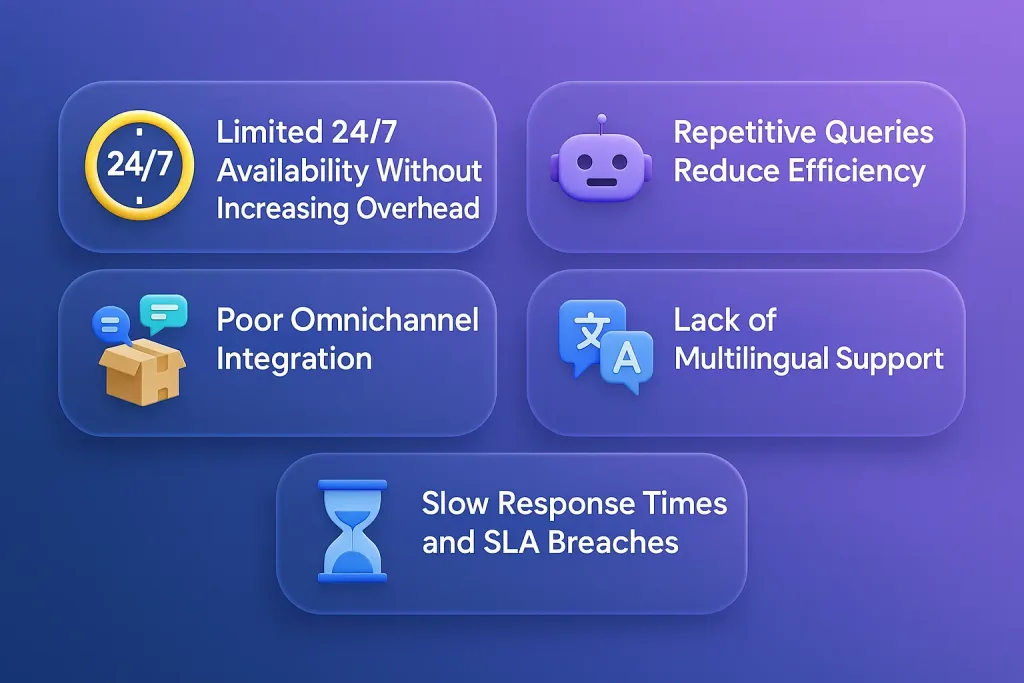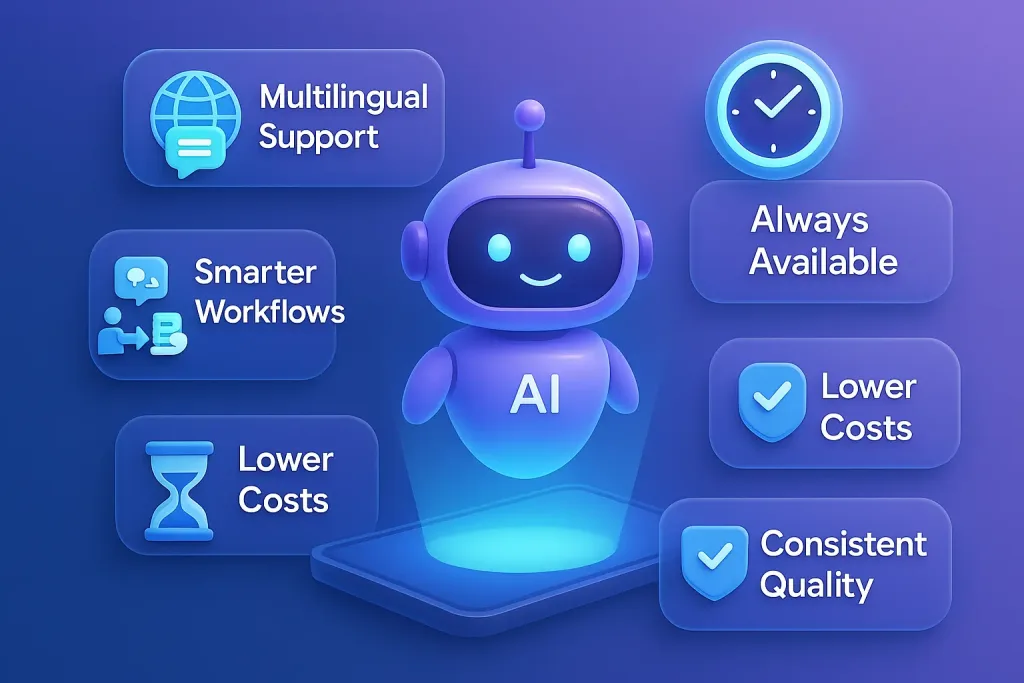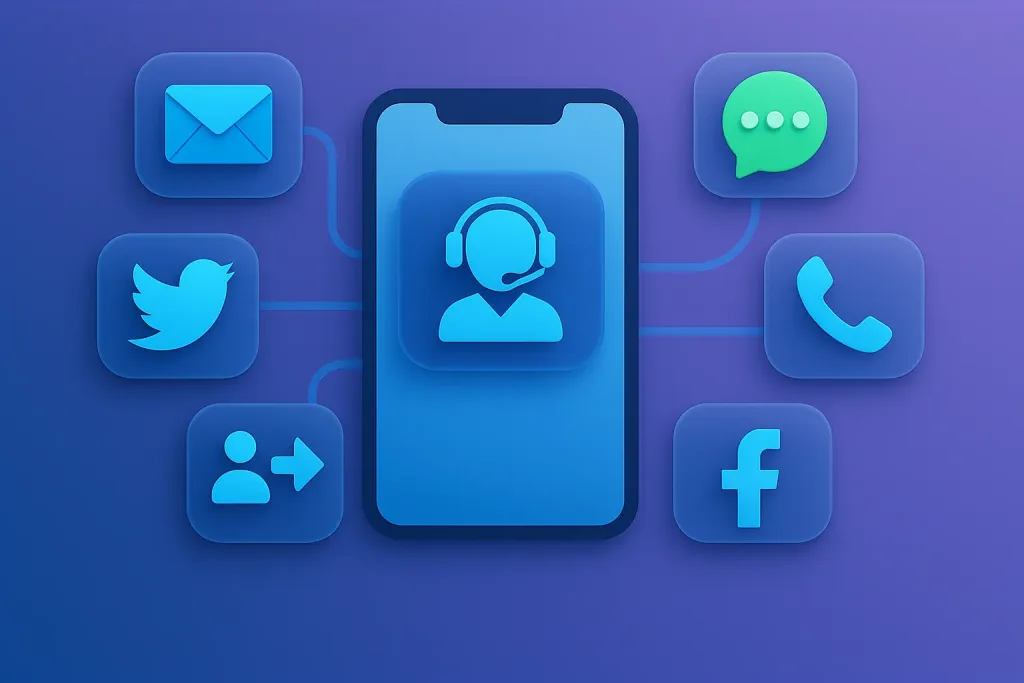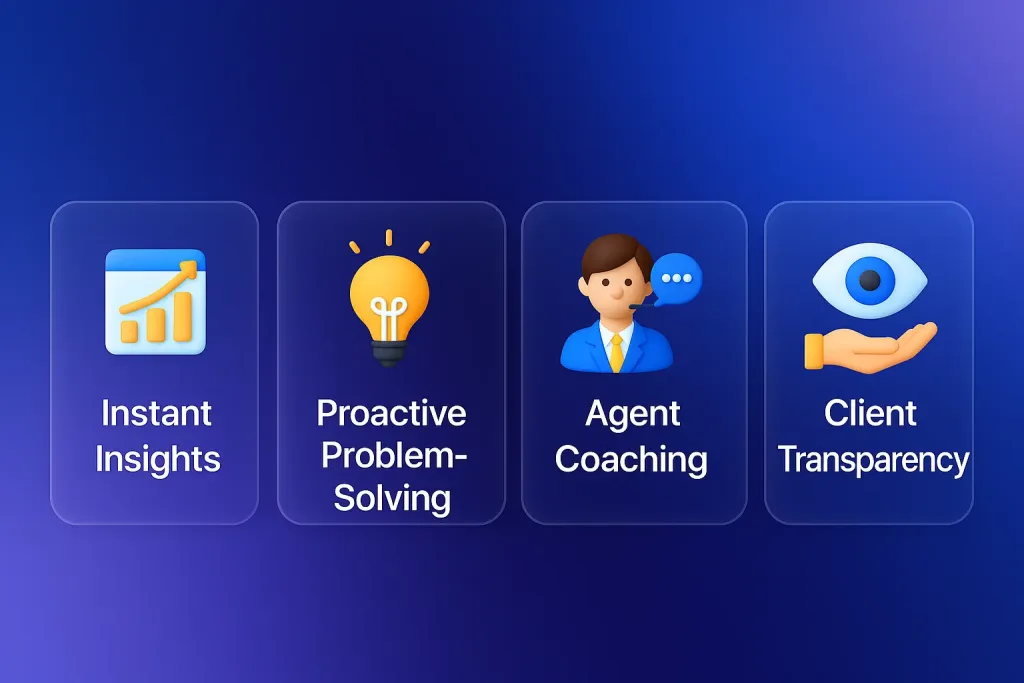10 Ways to Improve Customer Service in BPO
- July 13, 2025
- 12 mins read
- Listen

Over 85% of BPO companies now use AI-powered chatbots and messaging tools to support their customer interactions. (Statista)
This rapid adoption of automation highlights one thing clearly: customer service expectations are evolving fast, and the BPO industry is under pressure to keep up.
BPOs are no longer just about cost savings and scalability. Today, they’re expected to deliver fast, personalized, multilingual, and omnichannel customer experiences, all while handling high volumes and maintaining SLAs.
And with clients demanding more agility, transparency, and tech-driven support, BPO providers must rethink how they deliver service.
In this blog, we’ll explore the biggest challenges facing customer service in the BPO sector and share 10 actionable strategies to improve it.
Challenges of customer service in BPO

BPO customer service has several challenges, including limited 24/7 availability, high volume of repetitive queries, disconnected channels, and more.
Limited 24/7 availability without increasing overhead
One of the major challenges customer service in the BPO industry faces is maintaining round-the-clock service, which strains staffing, scheduling, and costs.
BPOs are expected to provide always-on support, especially for global clients. But hiring agents across multiple shifts and time zones comes with high operational expenses. Without automation or regional coverage, offering 24/7 support becomes unsustainable in the long run.
Deloitte’s Global Outsourcing Survey highlights that consistent 24/7 availability remains one of the top pain points in scaling outsourcing operations.
Repetitive queries reduce efficiency
Another challenge that BPOs face is that customer support teams spend hours on low-level, repetitive tasks. Most BPO agents handle hundreds of routine queries daily, including order status, password resets, and how-to instructions. This eats into productivity and delays responses to complex issues that require human attention.
According to Hubspot’s State of AI, 80% of customer support specialists agree that AI/automation tools can help them spend less time on manual tasks (data entry, scheduling meetings, etc.)
Poor omnichannel integration
Without omnichannel integration, customer journeys feel broken. And this is also a great challenge for a BPO. Customers don’t care what platform they’re using; they just want consistent, fast help.
But many BPOs still rely on siloed systems for live chat, email, calls, and social messaging. That leads to repeated conversations, context loss, and frustrated users. By providing consistent support, BPOs can improve customer experience.
Lack of multilingual support
A Forbes article emphasizes that multilingual support enhances comprehension and comfort, reinforcing customer value and satisfaction. As BPO clients grow globally, so do their language needs. But hiring native-speaking agents across all markets is expensive and not always scalable. Without multilingual support, customer satisfaction and loyalty take a hit.
Slow response times and SLA breaches
Delays in responding to customer queries result in missed SLAs and lower client satisfaction scores. Manual ticket routing, limited agent capacity, and lack of real-time insights contribute to this issue.
A SuperOffice study found that 62% of companies fail to respond to customer emails within 24 hours, leading to a poor customer experience.
10 effective ways to improve customer service in the bpo industry
Customer service in BPO is evolving through the use of AI, multilingual support, real-time analytics, and scalable solutions. Modern BPO providers help businesses deliver faster, more personalized, and cost-efficient support by combining human expertise with advanced customer service tools.
Here are ten effective ways BPOs are helping companies improve customer experience:.
1. Implement AI-powered chatbots

BPOs today use AI-powered chatbots and automation tools to provide 24/7 customer service, handling routine questions instantly so your customers never have to wait. For businesses serving global audiences, multilingual customer support, both by human agents and AI, ensures every customer gets clear, accurate help in their own language.
Here’s how AI chatbots improve BPO customer service:
- Always available: Support customers across all time zones without hiring night-shift agents.
- Multilingual support: Deliver native-language support using NLP-powered bots.
- Smarter workflows: Use bots to collect information before routing to live agents.
- Lower costs: Reduce the need for large support teams while improving resolution speed.
- Consistent quality: Ensure every customer gets accurate and consistent answers.
Pro tip: Choose a chatbot platform that integrates with your CRM, live chat, and ticketing system to streamline the entire support flow.
2. Use omnichannel platforms for seamless communication

Customers expect support on their terms, whether that’s over live chat, email, social media, or messaging apps. If your BPO is using disconnected tools for each channel, you’re likely missing context, duplicating efforts, and delivering a fragmented experience.
Omnichannel customer service platforms solve this by unifying all conversations into a single, shared dashboard. This means agents can instantly access full customer histories and switch between channels without losing context. And this brings the result of faster resolutions, fewer repeated questions, and a smoother support journey.
Why BPOs should adopt omnichannel platforms:
- Consistent experience: Deliver the same quality of service across chat, email, social, and more.
- Unified agent view: Give support teams complete conversation history in one place.
- Faster resolution: Cut down transfer times and avoid asking customers to repeat themselves.
- Better engagement: Reach customers on the channels they use most—WhatsApp, Facebook, Telegram, etc.
- Stronger relationships: Personalized, contextual replies make customers feel heard and valued.
Pro tip: Choose an omnichannel platform that supports real-time agent collaboration, co-browsing, and integrates with your help desk and CRM.
Learn more: Omnichannel Customer Service: Benefits, Strategies & Examples
3. Leverage real-time analytics and dashboards

If you can’t measure it, you can’t improve it. For BPOs, visibility into support performance is key, not just for client reporting, but for optimizing operations and scaling with confidence.
Real-time analytics tools give you an instant overview of what’s happening in your support queues. From agent productivity and customer satisfaction metrics to the most common support issues, dashboards help you spot trends, reduce bottlenecks, and improve service levels proactively.
Here’s how real-time analytics improve BPO performance:
- Instant insights: Monitor CSAT, AHT, FCR, and other key KPIs in real time.
- Proactive problem-solving: Identify drops in service quality before they escalate.
- Agent coaching: Use performance data to offer targeted training and support.
- Client transparency: Share live data with clients to build trust and accountability.
- Operational agility: Adjust staffing, routing, or workflows on the fly when needed.
Pro tip: Use dashboards that allow custom reporting so each client can track the metrics that matter most to them.
4. Provide multilingual support capabilities
When your clients serve global markets, language barriers can quickly become experience barriers. If customers can’t get help in their preferred language, it leads to confusion, frustration, and missed opportunities for your clients.
That’s why multilingual support is no longer optional; it’s a competitive advantage. BPOs can meet this demand by combining trained multilingual agents with AI-powered translation tools and multilingual chatbots. This hybrid approach ensures faster, clearer communication across borders.
Benefits of offering multilingual customer support in BPO:
- Wider market reach: Support clients with international audiences in local languages.
- Higher customer satisfaction: Customers feel more comfortable and valued when spoken to in their native language, and this improves customer satisfaction.
- Client retention: Multilingual capability helps you attract and retain enterprise clients expanding globally.
Pro tip: Consider platforms that offer multilingual chatbot support integrated with live chat and ticketing systems.
5. Invest in continuous agent training
Even the most advanced tools can’t replace well-trained, motivated agents. For BPOs, your agents are your frontline brand ambassadors, representing not just your business but your clients’ brands as well. And without regular training, their skills can quickly become outdated.
Investing in continuous training ensures your agents are prepared to handle evolving customer expectations, product updates, and communication trends. It also boosts confidence, reduces errors, and improves customer satisfaction across every interaction.
Why continuous agent training is a must for BPO success:
- Better product knowledge: Agents can resolve issues faster with a clear understanding of client offerings.
- Improved soft skills: Training enhances empathy, active listening, and tone, key to better CX.
- Higher first-call resolution (FCR): Well-trained agents solve more queries in the first interaction.
- Consistency across teams: Training standardizes responses, reducing variability across agents.
- Faster onboarding: Structured programs help new hires get up to speed quickly.
Pro tip: Use training data from your real-time analytics to tailor coaching sessions based on agent performance gaps.
6. Develop self-service portals and knowledge bases
Not every support query needs an agent. In fact, most customers prefer to solve simple issues on their own if you give them the tools to do so.
By offering a self-service portal or a well-structured knowledge base, BPOs can reduce ticket volume and free up agents to handle more complex interactions. These resources empower customers to find quick answers 24/7 while ensuring a consistent, accurate response to frequently asked questions.
How self-service tools improve customer support in BPOs:
- Consistent answers: A centralized knowledge base ensures all customers receive up-to-date, accurate information.
- Reduced support load: Fewer repetitive tickets mean your agents can focus on high-impact interactions.
- Customer empowerment: Users feel more in control when they can find answers themselves.
- Insight into customer behavior: Track search queries to improve content and identify gaps.
Pro tip: Regularly update your knowledge base based on new product features, ticket trends, and customer feedback.
7. Automate ticket routing and prioritization
When support tickets pile up, manually assigning them can delay responses and frustrate customers. That’s where automation comes in.
By implementing an automated ticketing system, BPOs can ensure every inquiry is instantly sent to the right agent based on factors like issue type, language, priority, or customer history. This reduces handling time and prevents tickets from falling through the cracks, especially during peak hours.
Why automated routing matters for BPOs:
- Faster response times: Assigning tickets instantly means no delays in customer support.
- Smarter resolutions: Route complex queries to senior agents and basic ones to junior reps or bots.
- Personalized experiences: Use customer data to route based on preferences or past behavior.
- Reduced manual effort: Eliminate back-and-forth between teams and increase agent productivity.
- SLAs made easier: Prioritize high-value or time-sensitive tickets to meet service level agreements.
Pro tip: Combine automation with real-time analytics to refine routing rules and improve first contact resolution.
8. Optimize workforce management
Even with the best tools, poorly managed teams can lead to long wait times, burnout, and poor customer experiences. That’s why efficient workforce management (WFM) is essential for BPOs to consistently deliver high-quality support.
By forecasting demand accurately and aligning agent schedules with real-time needs, BPOs can ensure the right number of agents are available at the right times. It’s not just about coverage, it’s about maximizing productivity while keeping service levels high.
Benefits of workforce optimization in customer service BPO:
- Better scheduling: Avoid understaffing during peak hours or overstaffing during lulls.
- Higher agent efficiency: Assign the right agents to the right tasks based on skill level and availability.
- Improved work-life balance: Balanced workloads reduce agent burnout and increase job satisfaction.
- Consistent service quality: Maintain SLAs by managing shifts, breaks, and rotations strategically.
- Data-driven decisions: Use forecasting tools to plan for spikes in demand or seasonal surges.
Pro tip: Integrate your WFM software with your omnichannel platform to gain real-time visibility into staffing needs across all support channels.
9. Collect and act on customer feedback
Customer feedback isn’t just a performance report; it’s a goldmine for improvement. Yet many BPOs either collect it without analysis or ignore it altogether. That’s a missed opportunity.
By actively collecting feedback through CSAT, NPS, or post-interaction surveys and acting on those insights, BPOs can improve service delivery, agent training, and client satisfaction. It also shows your clients that you’re serious about continuous improvement.
Why customer feedback matters in BPO customer service:
- Unfiltered insight: Get direct input from customers about what’s working—and what’s not.
- Improve service delivery: Use patterns in complaints or praise to refine processes.
- Strengthen agent performance: Recognize top performers and coach agents who need help.
- Boost client trust: Sharing insights with clients builds transparency and accountability.
- Drive innovation: Feedback often highlights features or changes customers want, guiding future improvements.
Pro tip: Don’t just collect feedback, close the loop. Follow up with customers to show you’ve listened and taken action.
10. Partner with technology-forward BPO providers
Technology-forward BPO providers leverage tools like AI chatbots, omnichannel platforms, real-time analytics, ticket automation, and CRM integrations to deliver faster, more personalized, and scalable customer service. For BPO buyers, choosing such a partner is not just smart, it’s essential for staying competitive.
Another important thing for BPO is keeping customer data safe. From using end-to-end encryption to following strict rules like GDPR and HIPAA, modern BPOs focus on strong security measures. This is essential because nearly all customers, around 95% say they won’t buy from a company that doesn’t protect their information.
What makes a BPO provider “technology-forward”?
- Seamless integrations: Platforms that connect easily with your CRM, helpdesk, and business tools.
- Real-time visibility: Dashboards that track performance, customer sentiment, and SLA compliance.
- Data-driven decision-making: Use analytics to continuously optimize CX strategy.
- Scalability and flexibility: Easily adapt to changing business needs without sacrificing quality.
Pro tip: When evaluating BPO vendors, ask about their tech stack and request a live demo of how their tools improve CX.
You may also like: AI in Customer Service: Benefits, Strategies & Examples
Wrapping up!
Customer service in the BPO world has come a long way. It’s no longer just about picking up calls or replying to emails. It’s about delivering fast, personalized, and consistent support through advanced technologies that keep customers coming back. Whether you are outsourcing to a BPO or managing support in-house, the ultimate goal is the same: happy, loyal customers.
But to meet growing expectations, you need the right tools. That’s where REVE Chat comes in. REVE Chat helps both BPOs and in-house teams offer excellent real-time customer service through a powerful suite of tools, AI chatbots, live chat, video chat, co-browsing, ticketing system, and more. Want to give it a shot? SIGN UP for REVE Chat’s 14-day free trial today!
Frequently Asked Questions
BPO (Business Process Outsourcing) is a broader concept where, as a business owner, you outsource various business functions to third-party service providers. These functions can include customer service, accounting, IT services, HR, and more.
Customer service, on the other hand, is just one aspect of BPO. It specifically involves assisting your customers with inquiries, complaints, or support needs.
Not exactly. A BPO (Business Process Outsourcing) refers to an entire company or service provider that handles various outsourced business functions. A call center agent, however, is an individual who works within a BPO and is responsible for handling customer issues and providing the required assistance.
The future of the BPO customer service industry is centered around digital transformation and innovation. With the rise of AI, automation, and omnichannel support, BPOs are shifting from traditional call handling to delivering smarter, faster, and more personalized customer experiences.
Quality customer service in a BPO means assisting your customers in a polite, quick, and empathetic way. It includes listening carefully, being empathetic, solving problems fast, and making sure the customer feels valued.
They need strong communication skills, patience, empathy, problem-solving abilities, product knowledge, and good listening skills. For assisting global customers, proficiency in multiple languages is also important.



